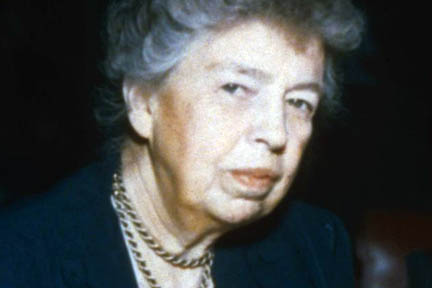
| Eleanor Roosevelt | |
|---|---|

White House portrait
|
|
| Chairwoman of the Presidential Commission on the Status of Women | |
| In office January 20, 1961 – November 7, 1962 |
|
| President | John F. Kennedy |
| Succeeded by | Esther Peterson |
| United States Delegate to the United Nations General Assembly | |
| In office December 31, 1946 – December 31, 1952 |
|
| President | Harry S. Truman |
| Chairman of the United Nations Commission on Human Rights | |
| In office 1946–1951 |
|
| Succeeded by | Charles Malik |
| United States Representative to the United Nations Commission on Human Rights | |
| In office 1947–1953 |
|
| Succeeded by | Mary Lord |
| First Lady of the United States | |
| In role March 4, 1933 – April 12, 1945 |
|
| Preceded by | Lou Hoover |
| Succeeded by | Bess Truman |
| First Lady of New York | |
| In role January 1, 1929 – December 31, 1932 |
|
| Preceded by | Catherine A. Dunn |
| Succeeded by | Edith Louise Altschul |
| Personal details | |
| Born | Anna Eleanor Roosevelt October 11, 1884 New York City, U.S. |
| Died | November 7, 1962 (aged 78) Manhattan, New York, U.S. |
| Resting place | Hyde Park, New York |
| Political party | Democratic |
| Spouse(s) | Franklin D. Roosevelt (m. 1905–1945; his death) |
| Relations | See Roosevelt family |
| Children | Anna, James, Franklin, Elliott, Franklin Delano, Jr., and John |
| Parents | Elliott Bulloch Roosevelt Anna Hall Roosevelt |
| Occupation | politician |
| Religion | Episcopalian |
| Signature | |
Anna Eleanor Roosevelt (/ˈɛlɨnɔr ˈroʊzəvɛlt/; October 11, 1884 – November 7, 1962) was an American politician, diplomat, and activist. She was the longest-serving First Lady of the United States, holding the post from March 1933 to April 1945 during her husband President Franklin D. Roosevelt's four terms in office. President Harry S. Truman later called her the "First Lady of the World" in tribute to her human rights achievements.
A member of the Roosevelt and Livingston families, Eleanor had an unhappy childhood, suffering the deaths of both parents and one of her brothers at a young age. At 15, she attended Allenwood Academy in London, and was deeply influenced by its feminist headmistress Marie Souvestre. Returning to the U.S., she married her fifth cousin once removed, Franklin Delano Roosevelt, in 1905. The Roosevelts' marriage was complicated from the beginning by Franklin's controlling mother, Sara, and after discovering Franklin's affair with Lucy Mercer in 1918, Eleanor resolved to seek fulfillment in a public life of her own. She persuaded Franklin to stay in politics following his partial paralysis from polio, and began to give speeches and campaign in his place. After Franklin's election as Governor of New York, Eleanor regularly made public appearances on his behalf. She also shaped the role of First Lady during her tenure and beyond.
Though widely respected in her later years, Roosevelt was a controversial First Lady for her outspokenness, particularly her stance on racial issues. She was the first presidential spouse to hold press conferences, write a syndicated newspaper column, and speak at a national convention. On a few occasions, she publicly disagreed with her husband's policies. She launched an experimental community at Arthurdale, West Virginia, for the families of unemployed miners, later widely regarded as a failure. She advocated for expanded roles for women in the workplace, the civil rights of African Americans and Asian Americans, and the rights of World War II refugees.
Following her husband's death, Eleanor remained active in politics for the rest of her life. She pressed the United States to join and support the United Nations and became one of its first delegates. She served as the first chair of the UN Commission on Human Rights, and oversaw the drafting of the Universal Declaration of Human Rights. Later she chaired the John F. Kennedy administration's Presidential Commission on the Status of Women. By the time of her death, she was regarded as "one of the most esteemed women in the world"; she was called "the object of almost universal respect" in her New York Times obituary. In 1999, she was ranked ninth in the top ten of Gallup's List of Most Widely Admired People of the 20th Century. (wikipedia)

